The benefits and harms of raw pumpkin: eating a fresh vegetable with maximum healing effect
Everyone is familiar with a vegetable like pumpkin. The oldest pumpkin seeds discovered by scientists are seven thousand years old. The color palette of the vegetable is simply amazing: solid, spotted, striped, green, yellow, orange, pink, and even white or black! Its forms are also different. It is known all over the world as it is very easy to care for and can grow in almost any climate.
But most of all, the beneficial properties of this plant are amazing. It fills the body with the power of vitamins and minerals, heals many diseases. The pumpkin was a frequent guest on the table of our ancestors, but in recent years it has been undeservedly forgotten. Now the fashion for her is returning. But what is the best way to use it? Is pumpkin safe to eat raw and what does it help with? Detailed answers to these and other questions are in our article.
The content of the article
Can I eat a raw vegetable
Pumpkin is used in different forms:
- pumpkin honey;
- boiled;
- baked pumpkin;
- pumpkin juice;
- pumpkin seeds;
- raw pumpkin.
The latter is considered the most useful. Why? Read about it below.
About the benefits and composition
Why is a raw product optimal for consumption? It contains a maximum of nutrients and fiber. But it is important to take into account the diseases (if any) and the individual characteristics of each organism (tendency to allergic reactions, etc.). Raw pumpkin is eaten by washing and grating or slicing. Monocomponent salads are also prepared from pumpkin with the addition of other healthy products, for example, with an apple.
What vitamins are in pumpkin
As we have already said, the yellow "fat woman" is a storehouse of useful substances:
- it contains vitamins of group B, vitamin E, C, H, K, PP, A, beta-carotene (provitamin A);
- trace elements: vanadium, boron, iodine, aluminum, iron, cobalt, manganese, chromium, selenium, rubidium, fluorine, zinc;
- carbohydrates - dextrins and starch, glucose, fructose, sucrose, monosaccharides, disaccharides;
- polyunsaturated fatty acids omega-3 and omega-6.
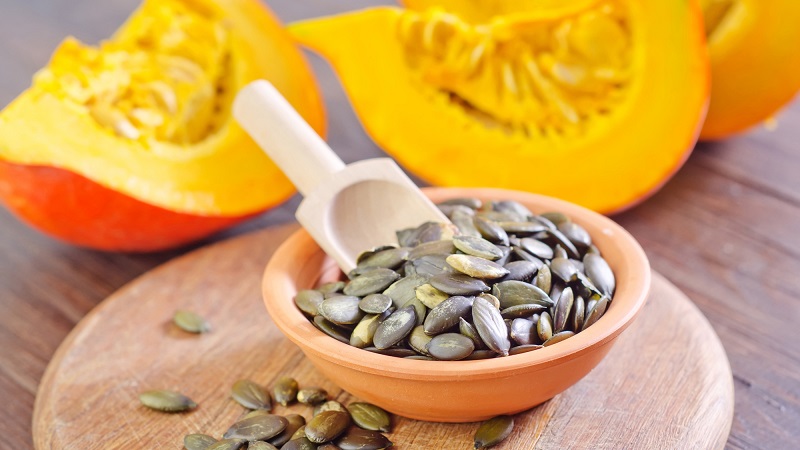
Why is this vegetable useful?
Consider the benefits and harms of a ginger vegetable. Pumpkin treats many diseases and has a beneficial effect on almost all body systems:
- It improves the functioning of the digestive system, helps food to be absorbed better and in a shorter period of time.
- The vegetable is often used in dietary nutrition, since it is low in calories, because most of its composition is water.
- Pumpkin effectively fights hypertension if consumed constantly. Blood pressure gradually normalizes and, as a result, headaches go away.
- "Plump" is rich in vitamins that have an antioxidant effect. It removes toxins, thus prolonging the youth of the body.
- Pumpkin masks are also good at fighting age-related changes. Those who use them regularly report a significant lifting effect. In addition, they are excellent for bleaching and fighting acne and inflammation, since the vegetable has antibacterial properties.
- The nervous system also “loves” our heroine, because the B vitamins it contains are simply necessary for her.
- Solves the problem of iron deficiency and has a positive effect on blood composition.
- Strengthens the walls of blood vessels, which prevents diseases such as varicose veins and thrombophlebitis.
- For eye diseases, the vegetable is also extremely useful.
- Regular consumption of melons and gourds strengthens the immune system, and its anti-inflammatory effect contributes to a speedy recovery from bronchopulmonary diseases, as the mucus that accumulates in the lungs is removed.
- Being an excellent remedy for thickening bile, pumpkin improves the functioning of the liver - the "chemical plant" of the body.
- The benefits of the vegetable are invaluable for the genitourinary system, as well as for male health.
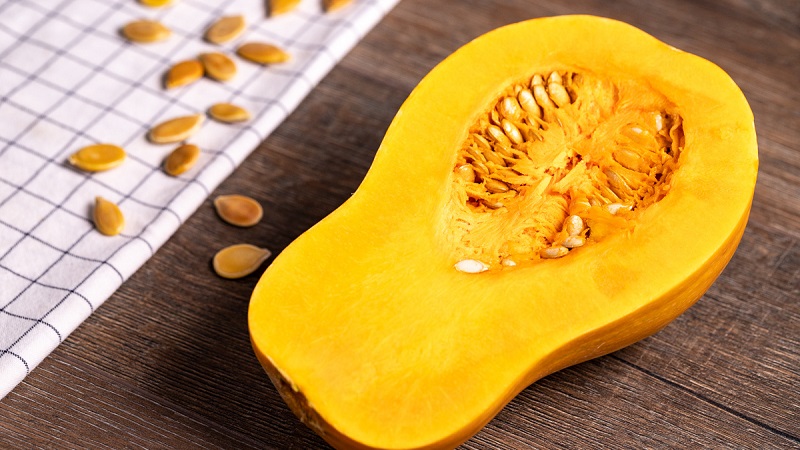
Do no harm
Is a berry vegetable always healthy? Almost all products have their pros and cons. The pumpkin also has them. It is contraindicated or it should be used extremely moderately:
- with individual intolerance, allergic reactions;
- with diabetes mellitus, it is undesirable to use varieties related to dessert;
- with exacerbations of diseases such as gastritis with low acidity, ulcers, pancreatitis, cholecystitis, bile and urolithiasis with large calculi (stones can begin to move and clog the ducts).
Exacerbation of liver diseases is also a reason to postpone the use of the product until the condition is normalized.
Be careful! If you have any health problems, be sure to consult a doctor before using pumpkin for dietary or medicinal purposes.
Calorie content and BZHU
The calorie content of the pumpkin is low. 100 g of the product accounts for only 30.45 kcal, or 127 kJ.
The next item of BZHU is proteins, fats and carbohydrates. Rather, their quantity is in a particular product.
BJU per 100 g of product:
- proteins - 1.20 g;
- fat - 0.27 g;
- carbohydrates - 6.98 g.
As a percentage, pumpkin contains 82.6% carbohydrates and 17.4% proteins and fats.
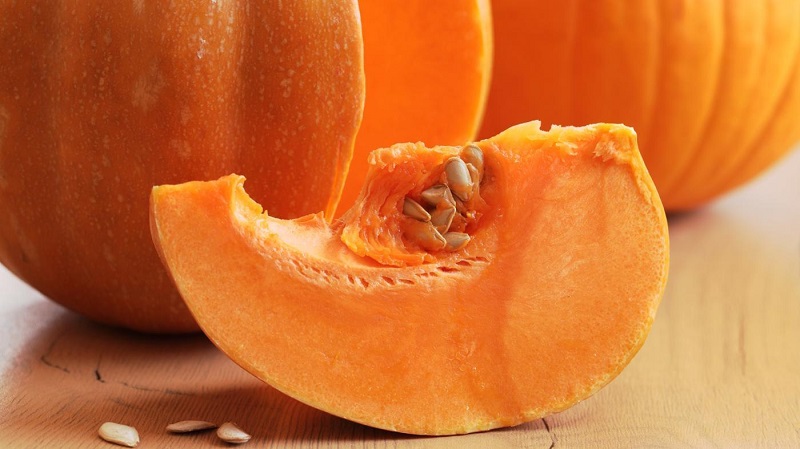
Yellow doctor in the garden - and there are no diseases among the people
Fresh pumpkin is beneficial for many diseases.
| Disease | What is useful | In what form is it applied | Dosage and method of administration |
| Kidney disease | Diuretic effect | Raw pulp, grated
|
3 tbsp. l. 4 times a day |
| Diseases liver | Choleretic effect, cleanses and restores liver parenchyma cells | Pumpkin honey (natural or cooked). They prepare honey at home like this. A barrel is made of pumpkin up to 1.5 kg and filled with honey. The “cap-hat” is tightly closed. Insist 7-10 days in the cold. | 1 tbsp. l. 3 times a day before meals for half an hour |
| Cirrhosis | Restores liver cells | Raw grated pumpkin or fresh pumpkin juice | Grated pumpkin is eaten in an amount of 0.5 kg or drunk in 0.5 tbsp. juice per day. The term of such treatment is 3 months.
|
| Acidic gastritis | Reduces inflammation, acidity and pain | Fresh juice | 200 g juice in the morning on an empty stomach |
| Anemia | Increases blood iron levels | Raw grated pumpkin | 150 g during the day until the condition normalizes |
| Pancreatitis in remission | Reduces inflammation, improves the functioning of the gastrointestinal tract, removes harmful substances | Fresh juice (can be mixed with apple or carrot 1: 1) | 0.5 tbsp. juice in 30 min. take before meals until the condition is stabilized |
Suitable for the whole family
As you know, the same products act differently depending on who, when and at what age they are taken. The norms and purposes of product use also differ depending on gender and age.
For men's health
Pumpkin has a positive effect on the functioning of the genitourinary system, eliminates inflammation in it. Therefore, it is especially useful for men as a prophylactic or therapeutic agent. The prostate gland is located next to the urinary system, and for its health it is necessary that there are no infections or inflammation around it. Benefits have long been known pumpkin seeds and fresh juice for male health and elimination of prostatitis.
In addition, the rich vitamin composition helps to maintain health and longevity and fills the body with such elements important for the male reproductive system as zinc and phosphorus.And linoleic and folic acids, which are part of the vegetable, promote the production of testosterone - the main male hormone.
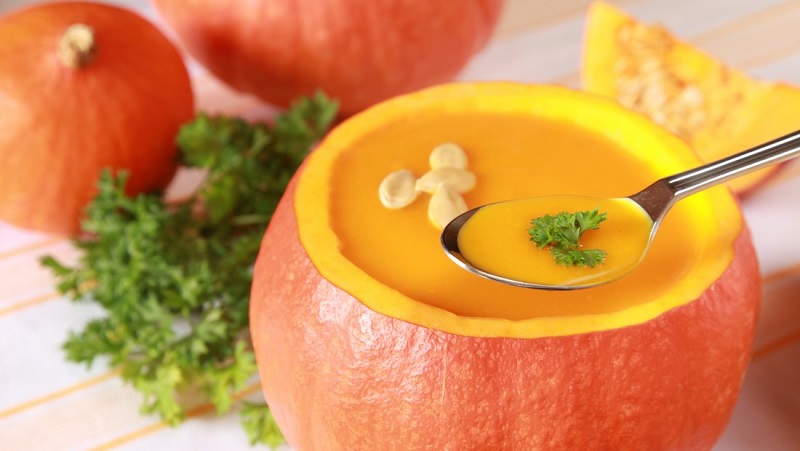
Good for women too
If a girl dreams of beautiful, delicate skin and attractive curls, she must certainly include pumpkin in her diet. Regular consumption of the vegetable helps to rejuvenate the body, cleanses it of toxins and toxins, which has a beneficial effect on the scalp and hair. The face tone becomes even, without acne and inflammation, hair splits less, dandruff disappears.
For the female reproductive system, the orange beauty is also useful. Just like men, she helps women get rid of unpleasant diseases, such as cystitis.
Children can
When deciding whether or not to give a pumpkin to a child, first of all, take into account the individual characteristics of his body and consult a pediatrician. If there is no individual intolerance and allergies, you can introduce the red "fatty" into the diet - just a little, like any new product. At the same time, carefully observe the reaction of the body.
There are many different opinions about the age at which children should be given pumpkin. It is generally accepted that it is possible to gradually introduce vegetable juice into the diet from four months, mashed potatoes from six, and soups from eight. But pumpkin is a strong allergen and, according to many pediatricians, up to six months, babies do not need any products other than breast milk. Therefore, it is better to postpone the introduction of the product into the diet until the baby reaches 6 months.
In general, the use of an orange vegetable is only beneficial, as it serves as an excellent prevention of iron deficiency and vitamin deficiency in a baby.
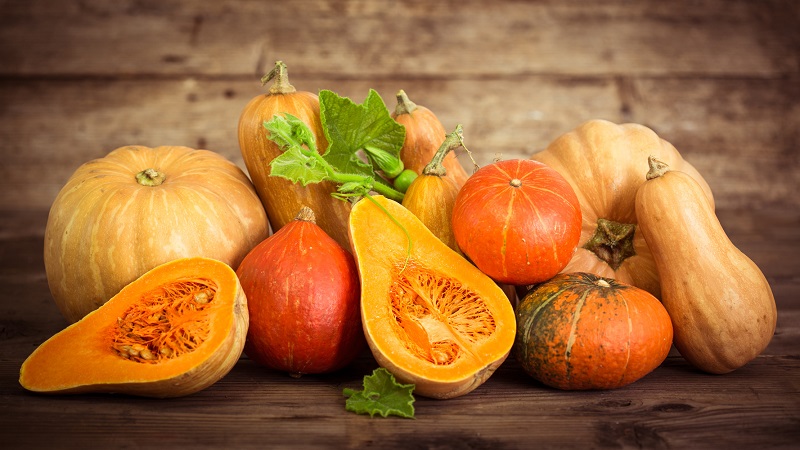
"Fatty" for weight loss
For those who want to lose weight, pumpkin is useful not only because of its low calorie content. Regular intake of the product activates metabolism and normalizes the digestive process. Saturation is faster thanks to natural fiber; as a result, the portion of food on the plate is reduced.
Pumpkin activates physical activity, as it increases endurance and serves as a natural energetic. Fasting days are spent with pumpkin - there are a lot of pumpkin diets. All this together helps to reduce weight. And if you continue to use pumpkin after losing weight, you can keep it stable at the same level.
Cooking pumpkin tasty and healthy
Pumpkin is eaten boiled, steamed, baked, but the raw product retains the greatest amount of nutrients. To make your meals as healthy as possible, you need to choose the right vegetable.
The fruit is chosen ripe, without rot and spoilage. It is defined as follows: the stalk is completely dry, the sound is dull when knocking, the pattern on the peel is clear, and if you press on the peel with your finger, there will be no traces.
So, you have chosen the pumpkin, it needs to be thoroughly washed, dried, and only then consumed. This will prevent germs from entering the peel. Now you can cook.
Important! When choosing a pumpkin, take a look at the longitudinal stripes. They should not be twisted or interrupted - this indicates a high content of nitrates in the fetus.
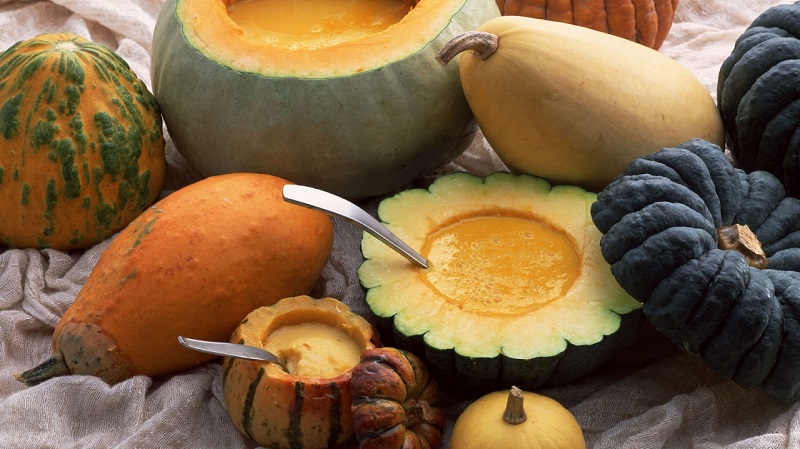
The pumpkin is raw, so delicious
There are a lot of recipes with raw pumpkin, although it is most often used for making salads, and sweet for desserts. Not only healthy fruits and vegetables are added to pumpkin, but even meat products. You can experiment endlessly here, changing traditional recipes with new ingredients.
Pumpkin porridge"
This dish can be called porridge rather conditionally, because it contains no cereals (neither boiled nor raw). But the dish turns out to be healthy and tasty.
You will need pumpkin pulp and carrots in equal shares, a sweet apple to taste, or half the mass of vegetables. Peel the ingredients, grind with a blender - the porridge is ready! You can add nuts, seeds, honey, dried fruits to it if you wish.
Pumpkin salad
You will need 100 g of raw pumpkin and carrots, 2 apples (sour or sweet, depending on taste), nuts and / or seeds, cinnamon on the tip of a knife, 1 spoon of honey, olive oil.Finely three vegetables, cut the apple into strips, season everything with butter and honey, sprinkle with seeds and nuts. A delicious and healthy dessert is ready.
Cheese salad
For a salad, you need 0.5 kg of pumpkin pulp, 100 g of any hard cheese and feta cheese, 1 apple, 1 bell pepper, 1-2 cloves of garlic, your favorite greens, a few walnuts, sour cream or mayonnaise. Finely chop the ingredients, mix, salt to taste, season with mayonnaise or sour cream, sprinkle with chopped nuts.
When you can't
Untreated pumpkin is not recommended for use during exacerbation of chronic diseases. Contraindications are gastritis with low acidity, colic, gastrointestinal ulcers, large stones in the gallbladder and kidneys, allergic reactions, individual intolerance.

Pregnant and lactating
Women in position and nursing mothers should be especially careful in the diet and use of any, even folk remedies. Therefore, before introducing pumpkin into the diet, it will not be superfluous to consult a specialist, because pumpkin has a number of contraindications, and in addition, it is considered a powerful allergen.
Nursing mothers should carefully monitor the condition of the baby. If a child develops colic, allergies, upset stools or carotenemia (expressed by yellowing of the skin), you must urgently stop taking the product and try to return to it after a while.
If there are no contraindications, the pumpkin will become a godsend for girls in position and young mothers. After all, it is not only low in calories and rich in nutrients, but also a real home doctor. The property of a vegetable is very valuable to gently relieve edema, and this, especially in late pregnancy, is relevant for many. In addition, pumpkin has a positive effect on the composition of the milk of a nursing mother and helps to restore the body after childbirth or eliminate toxicosis during pregnancy.
To help! If the mother's or baby's body does not respond too positively to raw pumpkin, try replacing it with stewed, boiled (in porridge) or baked.
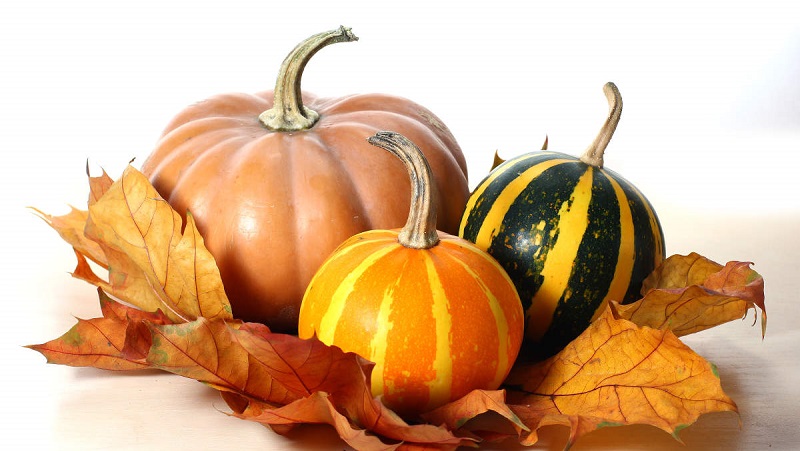
A few tips
Here are some simple guidelines to help you get the most out of your product:
- It is optimal if the pumpkin is grown on your own plot or bought on the market from a trusted seller, because a vegetable overloaded with nitrates will not be beneficial.
- In its raw form, pumpkin is the most useful, but also the most capricious to use, since problems with the gastrointestinal tract or allergies often occur. You can avoid unpleasant side effects by dividing the intake of the product into equal small doses.
- Begin to introduce pumpkin into the diet with small portions and only then gradually increase.
- Pumpkin juice is considered a powerful cleansing action when taken in the morning. Start taking it at the lowest dose, too.

Conclusion
Pumpkin is a healthy and valuable product. A person who watches over their health, dreams of beauty and longevity, must certainly add it to their diet. The effectiveness of vegetable treatment has been tested for more than one generation. Those who want to keep their figure or lose extra pounds should also pay attention to the "fat woman". It is low in calories, rich in fiber, and when used correctly, it starts the processes of purification and fat burning in the body.
Finally, it is a delicious product. There are many recipes with raw or thermally processed pumpkin, you can find for any, even the most demanding taste. And almost all dishes are prepared very simply. Many people have already come to love this healthy melon plant, and it has become a frequent guest on their table. Try its healing power and exotic taste too.